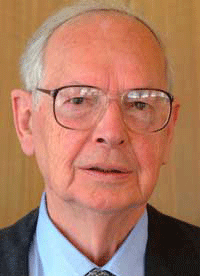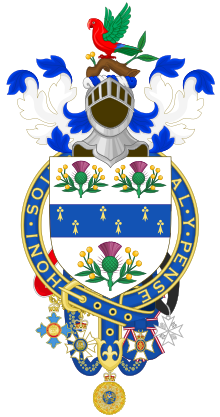Ninian Stephen
Sir Ninian Stephen | |
|---|---|
 | |
| 20th Governor-General of Australia | |
| In office 29 July 1982 – 16 February 1989 | |
| Monarch | Elizabeth II |
| Prime Minister | Malcolm Fraser (1982–83) Bob Hawke (1983–89) |
| Preceded by | Sir Zelman Cowen |
| Succeeded by | Bill Hayden |
| Justice of the High Court of Australia | |
| In office 1 March 1972 – 11 May 1982 | |
| Nominated by | William McMahon |
| Preceded by | Sir Victor Windeyer |
| Succeeded by | Sir William Deane |
| Judge of the Supreme Court of Victoria | |
| In office 30 June 1970 – 29 February 1972 | |
| Personal details | |
| Born | 15 June 1923 Henley-on-Thames, Oxfordshire, England |
| Spouse | Valerie Sinclair (1949–present) |
| Children | 5 |
| Profession | Barrister, judge |
| Military service | |
| Allegiance | Australia |
| Branch/service | Australian Army |
| Years of service | 1942–1946 |
| Rank | Lieutenant |
| Battles/wars | Second World War |
Sir Ninian Martin Stephen KG, AK, GCMG, GCVO, KBE, QC (born 15 June 1923) is an Australian jurist, who served as a Justice in the High Court of Australia before being appointed the 20th Governor-General of Australia.[1]
Early life and education
This section of a biography of a living person needs additional citations for verification. (March 2014) |
Stephen was born on 15 June 1923 in Henley-on-Thames, Oxfordshire, England.[2] He was less than a year old when his father, Frederick, who had been a motorcycle courier in World War I, died, leaving him to be raised by his mother Barbara.
Stephen attended St Paul's School, West Kensington, London, from Spring Term 1937 to March 1938.[3] He emigrated to Australia as a child.[citation needed]
Stephen was educated at Scotch College and the University of Melbourne, but his studies were interrupted by World War II, in which he served as a corporal in the Australian Army, 3rd Water Transport Group (Royal Engineers), in New Guinea and Borneo, rising to the rank of lieutenant before discharge in 1946.
Stephen completed his legal studies in 1950 and was called to the Victorian Bar in 1952.
Career
Legal career
By the 1960s, Stephen was one of Australia's leading constitutional and commercial lawyers. He was made a Queen's Counsel in 1966.[1]
Judicial career
On 30 June 1970, Stephen was appointed as a judge of the Supreme Court of Victoria, which is the highest ranking court in the Australian State of Victoria. He held this position until 29 February 1972, relinquishing it to take up his appointment as a Justice of the High Court of Australia.[1]
Although Stephen was appointed by a Liberal government, he proved not to be a traditional conservative upholder of states' rights. He joined the "moderate centre" of the court, between the arch-conservatism of Sir Garfield Barwick and the radicalism of Lionel Murphy. In 1982 he was part of the majority that decided on a broad interpretation of the "external affairs power" of the Australian Constitution in the Koowarta v Bjelke-Petersen case.
Governor-General
In March 1982, on the advice of the Prime Minister, Malcolm Fraser, Elizabeth II, Queen of Australia appointed Stephen as Governor-General.[1] He was sworn in on 29 July 1982, on the retirement of Sir Zelman Cowen. When Fraser was defeated by the Labor Party under Bob Hawke in 1983, Stephen had no difficulty working with a Labor government. In 1987, on Hawke's advice, the Queen extended Stephen's term by 18 months as a mark of personal respect and also to allow Bill Hayden (to whom Hawke had promised the position) to leave politics at a time of his choosing. Stephen is the only governor-general to have approved two double dissolutions – in 1983 (Malcolm Fraser) and 1987 (Bob Hawke).
Later work
In 1989, Stephen became the first Australian Ambassador for the Environment[1] and, in his three-year term, was particularly energetic in working for a ban of mining in Antarctica. In 1991 he undertook a difficult task when he was appointed chairman of the second strand of the Northern Ireland peace talks. From 1991 to 1995, he was a judge ad hoc of the International Court of Justice in the case East Timor (Portugal v. Australia) 1991–1995.[4] From 1993 to 1997, he was a judge on the international tribunals investigating war crimes in Yugoslavia and Rwanda. He has also been chairman of the Citizenship Council since 1998.[citation needed] In 1994, he acted as a special envoy of the UN Secretary General to resolve political conflicts in Bangladesh.[citation needed]
Stephen has since moved back into the legal field, becoming president of an arbitral tribunal constituted under Chapter 11 of the North American Free Trade Agreement (NAFTA), charged with the adjudication of an investment dispute between Mondev, a Canadian investor, and the United States of America.[5]
Titles, styles and honours
Stephen was made a Knight Commander of the Order of the British Empire (KBE) on 20 April 1972 "for distinguished services to the Law"[6] and sworn of the Privy Council in 1979. As Governor-General he was made a Knight of the Order of Australia (AK), Knight Grand Cross of the Order of St Michael and St George (GCMG) and Knight Grand Cross of the Royal Victorian Order (GCVO). In 1994 Queen Elizabeth II appointed him a Knight of the Garter (KG), being the most recent Australian to be granted a knighthood in the personal gift of the monarch of Australia. He therefore has the unusual distinction of holding five separate knighthoods and joined Lord Casey and Sir Paul Hasluck as one of the few Australian Knights of the Garter. In 1983 he was named a Commandeur of the French Légion d'honneur.[7][8][9]
Stephen delivered the first Sir Ninian Stephen Lecture at the University of Newcastle's law school in 1993, giving his name to this lecture series.[citation needed]
A detailed scholarly biography of Stephen, Fortunate Voyager by Philip Ayres, was released in September 2013.[10] Drawing upon it, Ayres has also summarised Stephen's career at the Victorian Bar.[11]
Titles
- Ninian Stephen (1923–1966)
- Ninian Stephen QC (1966–1970)
- The Hon. Ninian Stephen QC (1970–1972)
- The Hon. Sir Ninian Stephen KBE, QC (1972–1979)
- The Rt. Hon. Sir Ninian Stephen KBE, QC (1979–1982)
- His Excellency the Rt. Hon. Sir Ninian Stephen AK GCMG GCVO KBE QC (1982–1989)
- The Rt. Hon. Sir Ninian Stephen AK, GCMG, GCVO, KBE, QC (1989–1994)
- The Rt. Hon. Sir Ninian Stephen KG, AK, GCMG, GCVO, KBE, QC (since 1994)
Honours
- Orders
 1970 Knight Commander of the Order of the British Empire (KBE) [1][12]
1970 Knight Commander of the Order of the British Empire (KBE) [1][12] 1982 Knight of the Order of Australia (AK) [1][12]
1982 Knight of the Order of Australia (AK) [1][12] 1982 Knight Grand Cross of the Order of St Michael and St George (GCMG) [1][12]
1982 Knight Grand Cross of the Order of St Michael and St George (GCMG) [1][12] 1982 Knight Grand Cross of the Royal Victorian Order (GCVO) by Her Majesty, Queen Elizabeth II.[1][12]
1982 Knight Grand Cross of the Royal Victorian Order (GCVO) by Her Majesty, Queen Elizabeth II.[1][12] 1982 Knight of the Order of St John [1][12]
1982 Knight of the Order of St John [1][12] 1994 Knight of the Order of the Garter (KG) by Her Majesty, Queen Elizabeth II.[1][12]
1994 Knight of the Order of the Garter (KG) by Her Majesty, Queen Elizabeth II.[1][12]
- Medals
 1939–45 Star[12]
1939–45 Star[12] Pacific Star[12]
Pacific Star[12] War Medal 1939–1945[12]
War Medal 1939–1945[12] Australia Service Medal 1939–45[12]
Australia Service Medal 1939–45[12] 1977 Queen Elizabeth II Silver Jubilee Medal[12]
1977 Queen Elizabeth II Silver Jubilee Medal[12] 2006 Australian Defence Medal[12]
2006 Australian Defence Medal[12]
- Foreign honours
Appointments
- Personal
 1966 Queen's Counsel (QC)
1966 Queen's Counsel (QC) 1979 Privy Council of the United Kingdom (PC)
1979 Privy Council of the United Kingdom (PC)
Private life
Stephen married Valerie Sinclair in 1949 and they have five daughters. One of the daughters, Mary, was married to Peter Hayes QC.
Stephen and his wife are patrons of the Australian Inland Botanic Gardens.[13]
Arms

|
|
See also
- Judiciary of Australia
- List of Judges of the Supreme Court of Victoria
- Victorian Bar Association
- Australian knights and dames
References
- ^ a b c d e f g h i j k High Court of Australia (2010). "About the Justices". Retrieved 7 May 2011.
Sir Ninian Stephen (born 1923). A Justice 1972–82. Joined Victorian Bar 1952 (QC 1966). Served with AIF, World War II. Judge Supreme Court of Victoria 1970–72. Governor-General of Australia1982–89. Australian Ambassador for the Environment 1989–92. Chairman, Second Strand Nthn Ireland Peace Talks 1992. Judge International Tribunals for former Yugoslavia and Rwanda since 1993. PC (1979).
- ^ STEPHEN, NINIAN MARTIN, WW2 Nominal Roll.
- ^ Confirmed in St Paul's School Registers, pub. 1990.
- ^ East Timor (Portugal v. Australia), Judgment, I.C.J. Reports 1995, p. 90.
- ^ Mondev International Ltd. v. United States of America, ICSID Case No. ARB(AF)/99/2
- ^ "No. 45652". The London Gazette. 21 April 1972.
- ^ Philip Ayres. Fortunate Voyager: The Worlds of Ninian Stephen. Retrieved 19 July 2014
- ^ ABC Editorial Policies: About the Authors, p. 5. Retrieved 19 July 2014
- ^ Academy of the Social Sciences in Australia, Dialogue 22, 2/2003, p. 11. Retrieved 19 July 2014
- ^ Ayres, Philip (2013). Fortunate Voyager: The Worlds of Ninian Stephen. Carlton: Megunyah/Melbourne University Publishing. ISBN 9780522862089.
- ^ Ayres, Philip (Winter 2014). "Ninian Stephens at the Victorian Bar". Victorian Bar News. The Victorian Bar Inc. pp. 30–34. Retrieved 5 December 2014.
- ^ a b c d e f g h i j k l "Portraits of Australians". http://www.heidesmith.com/Portraits_Noted_Australians_One.html. Retrieved 1 February 2012.
{{cite web}}: External link in|work= - ^ "A community project". wentworth.nsw.gov.au. Retrieved 2 October 2009.
- ^ Banner of arms image, College of St George website. Retrieved 27 December 2013.
- ^ Banner of arms image. Arms shown over the crest (A parrot), a blue fess, tincture according to the torse. College of St George website. Retrieved 27 December 2013.
- ^ Crest image, Heraldic Sculptor. Retrieved 27 December 2013.
- ^ Order of Australia insignia. The Order of Australia Association. Retrieved 27 December 2013.
External links
- Use dmy dates from October 2012
- 1923 births
- Australian Army officers
- Australian military personnel of World War II
- Australian Queen's Counsel
- English emigrants to Australia
- Governors-General of Australia
- Judges of the Supreme Court of Victoria
- Justices of the High Court of Australia
- Australian Knights Commander of the Order of the British Empire
- Australian Knights Grand Cross of the Order of St Michael and St George
- Australian Knights Grand Cross of the Royal Victorian Order
- Australian Knights of the Garter
- Knights of the Order of Australia
- Commandeurs of the Légion d'honneur
- Living people
- Melbourne Law School alumni
- Members of the Privy Council of the United Kingdom
- People educated at Scotch College, Melbourne
- People from Henley-on-Thames
- People from Oxfordshire
- Queen's Counsel 1901–2000
- International Criminal Tribunal for the former Yugoslavia judges



